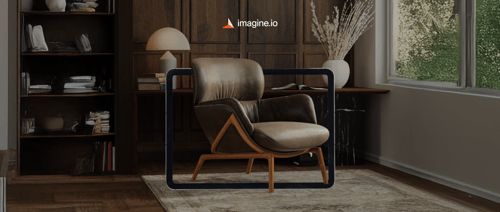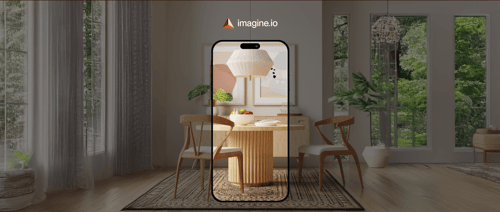Imagine standing in a furniture showroom, running your hand over a velvet sofa, picturing it in your living room. Now imagine doing the same from your phone spinning the sofa 360 degrees, switching its fabric to leather, and placing it virtually in your space. This isn't a sci-fi fantasy; it's the reality of configurable 3D imagery, and it's revolutionizing how consumers shop for high-ticket home goods like furniture, appliances, and premium décor. For brands in cities like Austin, New York, and Los Angeles, or across the U.S. and Canada, tools like imagine.io are building buyer confidence by making big purchases feel personal, precise, and risk-free.
The High Stakes of High-Ticket Purchases
High-ticket home goods custom sofas, designer lighting, or top-tier appliances carry a unique weight. These aren't impulse buys; they're investments, often costing thousands and expected to last for years. The challenge? Buyers face a maze of choices colors, finishes, sizes and the fear of a wrong decision looms large. Returns are costly, and static online images often leave shoppers guessing. According to a 2024 market analysis, the global customizable home decor market, valued at $9.5 billion, is projected to grow at a 9% CAGR, reaching $18 billion by 2032. This growth reflects a rising demand for personalized products like furniture, lighting, and textiles, where visualization tools are becoming essential to bridge the gap between imagination and reality.
Unlike everyday purchases, high-ticket items demand certainty. A platform like imagine.io steps in here, offering photorealistic, interactive visuals that let buyers tweak and test products virtually. The result? Decisions feel informed, not intimidating.
A New Era of Product Visualization
The home goods industry is embracing a visual transformation. Augmented reality (AR), virtual reality (VR), and interactive configurators are no longer niche they're redefining retail. Consumers now expect more than flat photos; they want dynamic, customizable visuals that mirror a showroom experience. Imagine.io's strength lies in its ability to create CGI so lifelike that even e-commerce experts can't tell it apart from traditional photography. This isn't just about aesthetics; it's about trust and engagement.
Social media amplifies this shift. Platforms like Instagram, LinkedIn, and YouTube are where buyers discover products, and interactive visuals think 360° spins or customizable videos keep them hooked. The U.S. home decor market, valued at $237.9 billion in 2024 and projected to reach $392.6 billion by 2030 at an 8.9% CAGR, is fertile ground for this technology. Furniture dominates revenue, while textiles are the fastest-growing segment, both benefiting from tools that make customization seamless.
Brands Putting Visualization to Work
Furniture That Feels Like Yours
Furniture retailers like King Koil and Serta Simmons are leading the charge. Their online configurators let customers swap fabric types, adjust sizes, or visualize a sofa in their own living room. This isn't just a gimmick it reduces uncertainty and return rates. Imagine.io's platform, for instance, generates these assets in minutes, letting brands showcase endless variations without costly photoshoots. For retailers in high-demand markets like Chicago or Dallas, this means meeting customer expectations with speed and precision.
Appliances That Click
Appliance shopping can be overwhelming models differ by finish, features, and dimensions. Brands like Maytag, KitchenAid, and Amana are using 360° imagery to simplify the process. Buyers can compare a glossy black dishwasher to a stainless steel one, spinning it to inspect every angle. This clarity turns complex decisions into confident ones, especially for consumers in tech-savvy hubs like Las Vegas or New York.
Lighting and Fixtures That Fit
Lighting brands like Kichler and Hunter Fan are also embracing 3D tools. A chandelier might dazzle in gold, but will it match your dining room's vibe? Configurable imagery lets buyers test finishes and styles in virtual spaces. Kohler's faucets follow suit, offering previews of how a matte black tap looks in a bathroom. For brands targeting design-conscious regions like Los Angeles or High Point, this customization drives engagement and sales.
Overcoming Adoption Hurdles
Despite its promise, configurable imagery faces resistance. Some brands shy away from subscription models like imagine.io's, favoring one-time project fees. The platform's custom pricing, while tailored to each client, can feel complex compared to competitor's simpler packages. Additionally, imagine.io isn't always part of established agency networks, requiring brands to trust a newer player. Yet, these objections are fading as companies see tangible benefits: faster asset creation, higher conversions, and scalable solutions for complex catalogs.
For instance, imagine.io's cloud-based platform generates unlimited images, a boon for brands like Ruggable or Sinomax-USA with sprawling product lines. The proof is in the numbers fewer returns, more sales, and happier customers.
The Business Case for Configurable Imagery
Speeding Up the Market
Traditional photoshoots are a bottleneck expensive and time-consuming. Imagine.io's cloud platform churns out assets in minutes, letting brands launch seasonal collections or promotions at lightning speed. For markets like the U.S. and Canada, where trends shift fast, this agility is a competitive advantage.
Boosting Conversions
Uncertainty kills sales. Configurable imagery removes the guesswork, letting buyers see exactly what they're getting. Whether it's a PepsiCo-partnered retail display or a KegWorks bar accessory, clear visuals drive confident purchases. Studies show that interactive tools can increase conversion rates by reducing cart abandonment, a critical edge in e-commerce.
Scaling for Growth
Large catalogs think thousands of SKUs are a logistical challenge. Imagine.io's unlimited asset generation lets brands like Diageo or Kohler scale effortlessly, creating variations for every product without ballooning costs. This is a lifeline for retailers managing high-volume inventories across regions like Austin or Canada.
Social Media That Sells
Interactive visuals are a magnet on social platforms. A YouTube video of a customizable Ruggable rug or an Instagram post showing a Hunter Fan in multiple finishes grabs attention. These platforms LinkedIn, Instagram, Facebook, and YouTube are where buyers browse, and dynamic imagery keeps them engaged, driving clicks and conversions.
The Future of Confident Shopping
The home goods market is at a crossroads. As photorealistic CGI becomes indistinguishable from traditional photography, brands adopting tools like imagine.io will lead the pack. Experts predict that within three to five years, configurable imagery will be standard for premium retail, from furniture to appliances. For manufacturers and retailers in key regions like Chicago, Dallas, or Canada, the message is clear: act now or risk falling behind.
The U.S. home decor market is charging toward $392.6 billion by 2030, fueled by demand for personalization and technology. Tools like imagine.io aren't just enhancing the shopping experience they're redefining it. Every 3D spin, every customized preview, brings buyers closer to certainty. In a world where confidence drives sales, that's not just progress; it's the future.
Frequently Asked Questions
How does configurable 3D imagery help with buying expensive furniture online?
Configurable 3D imagery allows customers to interact with furniture virtually by spinning products 360 degrees, switching materials like fabric to leather, and even placing items in their own living spaces using AR technology. This technology reduces the uncertainty that comes with high-ticket purchases by letting buyers see exactly what they're getting before spending thousands of dollars. Studies show that interactive visualization tools can significantly increase conversion rates by reducing cart abandonment and return rates.
What are the main benefits of using photorealistic CGI for home goods retailers?
Photorealistic CGI offers three key advantages: speed, cost-effectiveness, and scalability. Instead of expensive, time-consuming traditional photoshoots, retailers can generate unlimited product variations in minutes using cloud-based platforms. This allows brands to quickly launch seasonal collections, create thousands of SKU variations without ballooning costs, and produce engaging content for social media platforms like Instagram and YouTube that drives higher customer engagement and sales.
Which major home goods brands are successfully using configurable imagery technology?
Leading brands across furniture, appliances, and fixtures are embracing this technology. Furniture retailers like King Koil and Serta Simmons use online configurators for fabric and size customization, while appliance brands like Maytag, KitchenAid, and Amana offer 360° imagery for comparing finishes and features. Lighting companies such as Kichler and Hunter Fan, plus fixture brands like Kohler, use 3D tools to help customers visualize products in virtual spaces before making purchasing decisions.
Disclaimer: The above helpful resources content contains personal opinions and experiences. The information provided is for general knowledge and does not constitute professional advice.
You may also be interested in: Imagine.io | Award Winning 3D + AI Product Visualization
Struggling with expensive, outdated product visuals that slow down your creative process and stunt eCommerce growth? imagine.io's AI-powered platform empowers furniture, home décor, and textile brands to effortlessly produce striking 3D images, immersive videos, AR experiences, and interactive configurators. Cut production costs up to 70%, boost conversions 5X, speed up prototyping, and supercharge your online sales. Ready to elevate your product visuals and captivate customers? Book a demo with imagine.io today!
Powered by flareAI.co




.png?width=500&name=How%20to%20Add%20a%203D%20Product%20Configurator%20to%20Your%20WordPress%20Website%20(Complete%20B2B%20Guide).png)
















%20(1).png?width=500&name=Why%20Exploded%20Mattress%20Views%20Matter%20(And%20How%20to%20Generate%20Them)%20(1).png)
.png?width=500&name=Best%20Shopify%20Product%20Configurator_%20How%20to%20Choose%20the%20Right%20One%20(2).png)
.png?width=500&name=Why%20Exploded%20Mattress%20Views%20Matter%20(And%20How%20to%20Generate%20Them).png)



.png?width=500&name=Best%20Shopify%20Product%20Configurator_%20How%20to%20Choose%20the%20Right%20One%20(1).png)







.png?width=500&name=How%203D%20Rendering%20Can%20Make%20or%20Break%20Your%20Industrial%20Design%20Pitch%20(1).png)








%20with%20Digital%20Twins%20and%203D%20Visualization.png?width=500&name=Optimizing%20Your%20Digital%20Asset%20Management%20(DAM)%20with%20Digital%20Twins%20and%203D%20Visualization.png)




.png?width=500&name=Styling%20Home%20Decor%20for%202025_%20From%20Global%20Influences%20to%20Playful%20Personalization%20(1).png)
